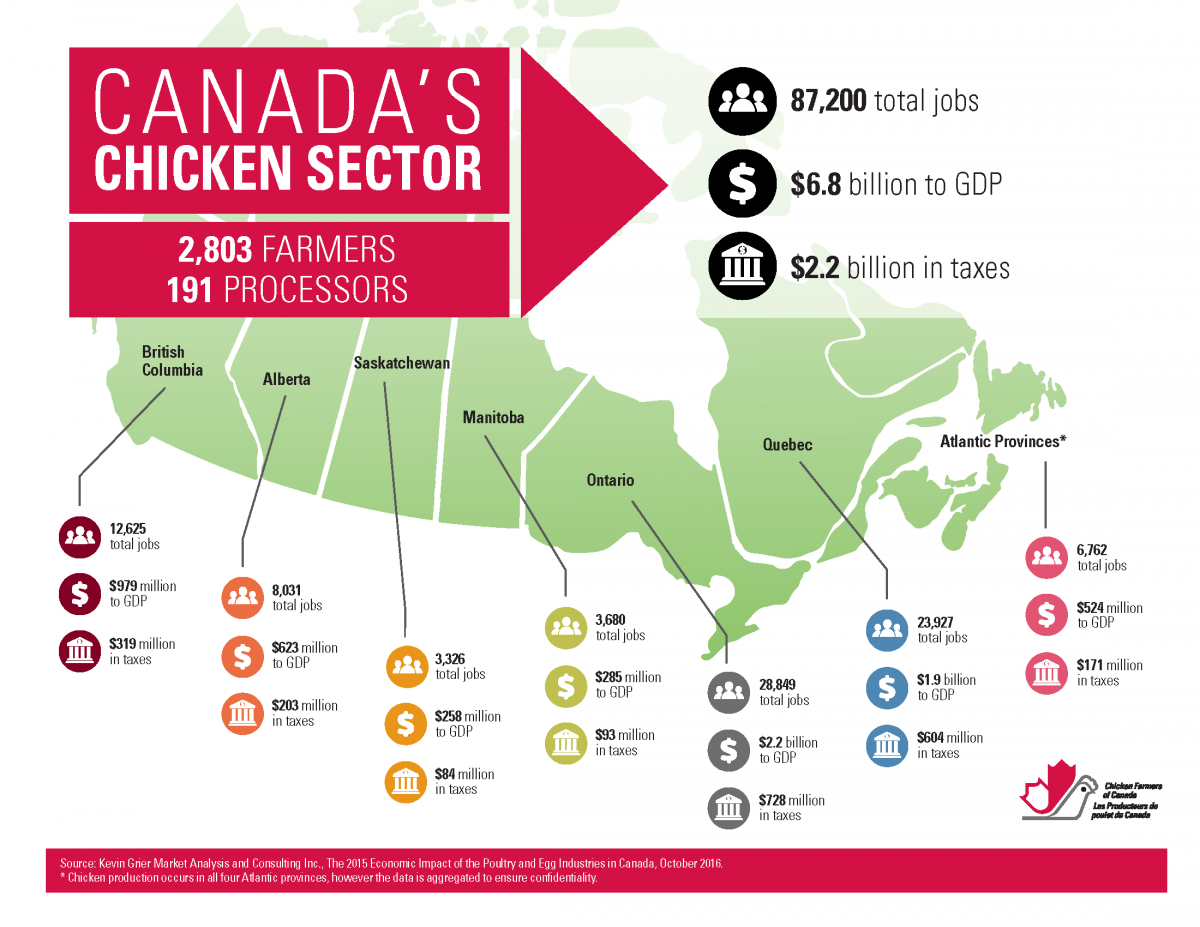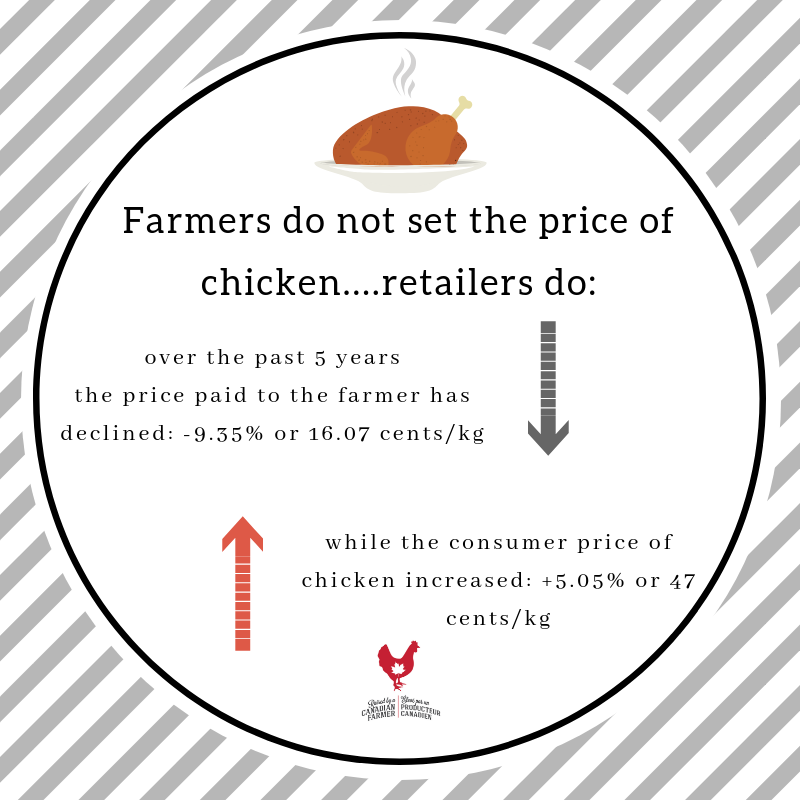Chicken Industry
Buy Canadian - here's how!
Supply Management
The Alberta chicken industry operates under supply management, which provides Albertans with a consistent supply of locally produced, affordable, high quality chicken products. Supply management has been serving Canadian consumers and chicken farmers since the early 1970s.
Economic Contribution

Benefits of Supply Management
- Consumers have access to locally produced chicken products raised on our family farms in their local grocery stores and restaurants
- Ensures a sustainable, consistent local food supply for consumers
- Governments do not pay subsidies to support the income of our farmers
- Ensures a stable, fair price for consumers and producers. Supply Management does not set the price at retail - retailers set the price consumers pay
- Innovation - Our producers are committed to uphold mandatory food safety and animal care standards
Supply Management Mythbusting
- Canadian Chicken Farmers - Among the Hardest Working People You'll Meet
- Effect on other sectors
- Supply Management and Job Creation
- Efficiency and Fairness
- The True Focus of International Trade Agreements
- Supply Management is NOT a Powerful Lobby
- Supply Management and Consumer Pricing
- Supply Management and Free Trade Agreements
- Supply Management Ensures Foods Safety
- Supply Management is NOT a Tax on the Poor
- Young or Old, Big or Small, Supply Management Helps All
How it Works
Quota is granted by the Board to a farmer to engage in the production and marketing of the chicken. Quota provides them with the right to produce. Quota can be obtained by either purchasing or leasing-in from a certified chicken farmer in Alberta.
Production Planning
Farmers and industry stakeholders plan production to supply quality food that reflects consumer demand. This provides predictability and stability so that industry stakeholders can invest with confidence.
Producer Pricing
To remain competitive with other provinces, the live price of chicken is based off of the Ontario live price. While farmers set the farm gate price, they do not set wholesale or retail prices. Retailers set the prices paid by consumers based on what the market can bare.
Import Controls
Controlling imports of chicken allows Canadian farmers to meet the domestic demand for chicken. Predictability of imports, through effective tariff rate quotas, help to stabilize the supply of chicken in the market. Canada is still the 16th largest importer of chicken globally.
More about Marketing, Quota & Allocation
On average, a 40 g chick will grow into a 2.2 kg bird in 38 days. Feed conversion is approximately 1.80–2.00 kg feed/kg meat.
Most broilers are marketed at approximately 35-39 days, leaving the remainder of the 8-week cycle for clean-up, repairs and preparation for placement of the next flock. Revenue is generated over 6.5 cycles per year.
Quota
1 quota unit = approximately 20 kg chicken / year Formula: Kg’s = # units x 0.50 x # weeks in cycle (8)* x 6.5 cycles per year *Varies depending upon the type of bird grown. 8 weeks is the average for broilers.
Quota Units are allocated to existing producers and new producers in the province. Quota Units can be purchased or leased from one licensed producer to another upon approval by the Board. The maximum amount of quota an individual producer is permitted to own is 5% of the total provincial quota. A farm with more than one person involved in the operation of the particular farm, such as a partnership, is permitted 10% of the provincial quota. In the case where financial institutions have filed a Financial Interest or an Appointment of Attorney with the Board office, we are obligated to notify those financial institutions of the Producers' request to sell quota (reallocate quota units).
For more information, please refer to our Operations Policy Manual.
Allocation
Chicken Farmers of Canada is the national agency that oversees the orderly marketing of chicken in Canada. Farmers, processors, further processors and members of the restaurant industry from across the country meet every eight weeks to determine anticipated market requirements and set production levels accordingly.
Each province in Canada obtains a share of the national allocation, and the provincial marketing boards in turn allocate production to individual producers. The quota utilization percentage changes from cycle to cycle in order to respond to market demand for chicken meat.
For example, at a 100% quota utilization, a producer is able to market 4.00 kg for every 1 unit of quota.
Formula: Kg's = [1 (quota unit) x .50 (conversion factor) x 8 (week cycle) X 100% (percentage of utilization)]
Market Development
The Market Development Program maintains a balance of white and dark meat on the domestic markets. Since their demand is often not equal, the program ensures an adequate supply of white meat is supplied to meet domestic demand, and excess dark meat is exported. Processors who develop export markets extend an offer to producers to grow chicken for the export market. Market Development production is applied for by processors, and cannot exceed 14% of the provincial allocation. Nationally, Market Development accounts for roughly 6% of production and in Alberta, Market Development accounts for approximately 3.5-4% of total production annually.
Chicken Prices - Farmers Share
Retailers and restaurants set the prices paid by consumers.
Farmers actually receive only a small percentage of the consumer dollar that is spent on food. In most cases, the farmer’s share is less than the taxes on the meal itself, and much less than the tip or gratuity given to the person that spends 1 hour serving you in the restaurant.

Learn About a Chicken Farmer's Share of a Restaurant Meal
Farmers Don’t Set Retail Prices
At the retail level, chicken is sold at a variety of price levels and consumers have access to a wide variety of cuts and types of product that were developed in response to consumer demand. These products are sold at whatever price that consumers will pay – all without any influence from the farmer.
Retail pricing is influenced by many factors, only one of which is the farmer’s share. Others include retailer competition, brand positioning, cost of competing meats, store specials – all of which usually cause price fluctuations that are greater than the share the farmer receives. Prices can vary from week to week, from region to region, from store to store, and from product to product. This demonstrates that the farmer’s share is not the driver of retail pricing.
No Subsidies
And the fact is, our farmers only get paid for the chicken they sell and the pricing is transparent. There are no hidden subsidies. Only chicken consumers pay for chicken. This is not the case for other commodities which have received substantial financial support from federal and provincial governments. Through their taxes, Canadians pay for beef and pork whether they consume it or not. They even pay for consumers in other countries to eat our beef and pork that is sold around the globe.
The farmer’s share is a small percentage of the final sale price of chicken sold in Canada, but is no less important because it sustains our family farms and ensures that families like yours can continue to buy our fresh, safe and delicious chicken for generations to come.
Canadian Poultry Research Council
The Canadian Poultry Research Council (CPRC) is an industry-led organization with a mandate to support poultry research in Canada. The Chicken Farmer’s of Canada, Alberta Chicken Producer’s national counterpart, is a member of the CPRC.
Poultry Research Centre
The Poultry Research Centre is a unique partnership between the University of Alberta, Alberta Agriculture and Forestry, and the poultry industry. Alberta Chicken Producer’s is a member of the Poultry Research Centre’s Advisory Board.
Trade
There’s been talk recently about opening the market to more imports, displacing the local and reliable foods Canadians trust, and placing the livelihoods of the farm families who grow them at risk.
Trade rules are critical to the Canadian chicken industry in order to maintain the three pillars of supply management: producer pricing, production discipline, and import controls. The import controls pillar continues to be challenged from several different directions: the Duties Relief Program, spent fowl imports and of specially defined mixtures.


